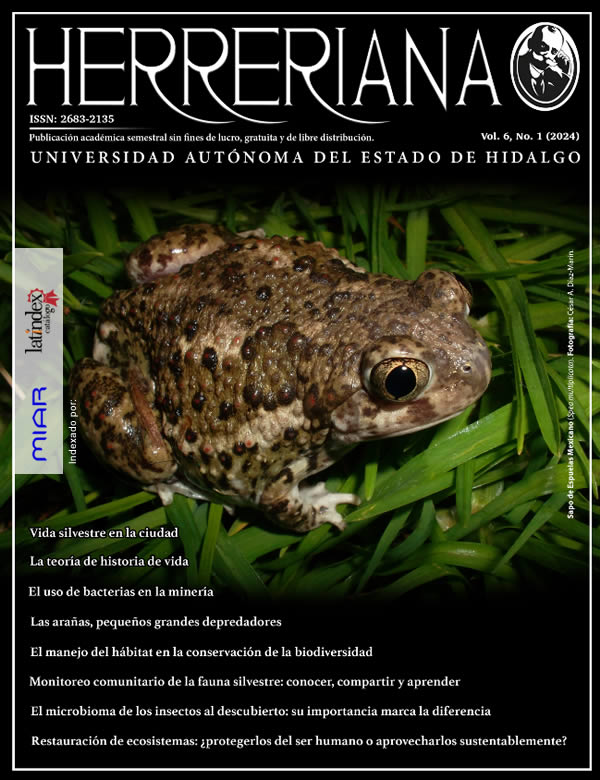El microbioma de los insectos al descubierto: su importancia marca la diferencia
DOI:
https://doi.org/10.29057/h.v6i1.11564Palabras clave:
bacterias, hongos, paratransgénesis, protistas heterotróficos, virusResumen
Los insectos tienen interacciones con microorganismos (bacterias, hongos, protistas, virus y arqueas) benéficos o perjudiciales que viven en su cuerpo y conforman su microbioma. Este puede influir en el comportamiento y desarrollo de los insectos, en tanto que los insectos pueden moldear su microbioma al ingerir alimentos con microorganismos beneficiosos, lo cual desempeña un papel crucial en la evolución de estos animales al interactuar con su genoma y afectar su adaptabilidad. El microbioma tiene un gran potencial en aplicaciones prácticas, como la agricultura, la salud animal y la biotecnología con el uso de la paratrangénesis (uso de un microbioma de los insectos manipulado genéticamente) como una nueva forma de controlar las poblaciones de insectos o su capacidad para transmitir enfermedades.
Descargas
Información de Publicación
Perfiles de revisores N/D
Declaraciones del autor
Indexado en
- Sociedad académica
- N/D
- Editora:
- Universidad Autónoma del Estado de Hidalgo
Citas
Blow, F. y Douglas, A. E. (2019). The hemolymph microbiome of insects. Journal of Insect Physiology, 115, 33-39. https://doi.org/10.1016/j.jinsphys.2019.04.002
Elston, K. M., Leonard, S. P., Geng, P., Bialik, S. B., Robinson, E. y Barrick, J. E. (2022). Engineering insects from the endosymbiont out. Trends in Microbiology, 30(1), 79-96. https://doi.org/10.1016/j.tim.2021.05.004
Engel, P. y Moran, N. A. (2013). The gut microbiota of insects–diversity in structure and function. FEMS Microbiology Reviews, 37(5), 699-735. https://doi.org/10.1111/1574-6976.12025
Ferguson, L. V., Dhakal, P., Lebenzon, J. E., Heinrichs, D. E., Bucking, C. y Sinclair, B. J. (2018). Seasonal shifts in the insect gut microbiome are concurrent with changes in cold tolerance and immunity. Functional Ecology, 32(10), 2357-2368. https://doi.org/10.1111/1365-2435.13153
Gurung, K., Wertheim, B. y Falcao Salles, J. (2019). The microbiome of pest insects: it is not just bacteria. Entomologia Experimentalis et Applicata, 167(3), 156-170. https://doi.org/10.1111/eea.12768
Gupta, A. y Nair, S. (2020). Dynamics of insect–microbiome interaction influence host and microbial symbiont. Frontiers in Microbiology, 11, 1357. https://doi.org/10.3389/fmicb.2020.01357
Jordan, H. R. y Tomberlin, J. K. (2021). Microbial influence on reproduction, conversion, and growth of mass-produced insects. Current Opinion in Insect Science, 48, 57-63. https://doi.org/10.1016/j.cois.2021.10.001
Jupatanakul, N., Sim, S. y Dimopoulos, G. (2014). The insect microbiome modulates vector competence for arboviruses. Viruses, 6(11), 4294-4313. https://doi.org/10.3390/v6114294
Kageyama, D., Narita, S. y Watanabe, M. (2012). Insect sex determination manipulated by their endosymbionts: incidences, mechanisms and implications. Insects, 3(1), 161-199. https://doi.org/10.3390/insects3010161
Lee, M., Kalamarz, M., Paddibhatla, I., Small, C., Rajwani, R. y Govind, S. (2009). Virulence factors and strategies of Leptopilina spp.: selective responses in Drosophila hosts. Advances in parasitology, 70, 123-145. https://doi.org/10.1016/S0065-308X(09)70005-3
Lewis, Z. y Lizé, A. (2015). Insect behaviour and the microbiome. Current Opinion in Insect Science, 9, 86-90. https://doi.org/10.1016/j.cois.2015.03.003
Liu, X., Floate, K. D., Gorzelak, M. A., Holman, D. B., Hrycauk, S., Kubota, H., Lupwayi, N., Neilson, J., Ortega, R., Petri, R., Tran, L., Wang, H., Wilches, D., Yang, X., Zorz, J. y Guarna, M. (2023). Prairie agroecosystems: interconnected microbiomes of livestock, soil and insects. Agriculture, 13(2), 326. https://doi.org/10.3390/agriculture13020326
López-Reyes, N., Ábrego-García, A. y Poggi-Varaldo, H. (2022). Mecanismos de inhibición de la metanogénesis con lovastatina y análisis de la expresión génica. Revista Internacional de Contaminación Ambiental, 38, 58-67. https://doi.org/10.20937/RICA.54357
Morgan-Richards, M., Marshall, C. J., Biggs, P. J. y Trewick, S. A. (2023). Insect freeze-tolerance downunder: the microbial connection. Insects, 14(1), 89. https://doi.org/10.3390/insects14010089
Muñoz-Benavent, M., Perez-Cobas, A. E., Garcia-Ferris, C., Moya, A. y Latorre, A. (2021). Insects’ potential: understanding the functional role of their gut microbiome. Journal of Pharmaceutical and Biomedical Analysis, 194, 113787. https://doi.org/10.1016/j.jpba.2020.113787
Negri, I., Pellecchia, M., Mazzoglio, P., Patetta, A. y Alma, A. (2006). Feminizing Wolbachia in Zyginidia pullula (Insecta, Hemiptera), a leafhopper with an XX/X0 sex-determination system. Proceedings: Biological Sciences, 273(1599), 2409-2416. https://doi.org/10.1098/rspb.2006.3592
Ratcliffe, N. A., Furtado Pacheco, J. P., Dyson, P., Castro, H. C., Gonzalez, M. S., Azambuja, P. y Mello, C. B. (2022). Overview of paratransgenesis as a strategy to control pathogen transmission by insect vectors. Parasites & Vectors, 15(1), 112. https://doi.org/10.1186/s13071-021-05132-3
Ren, L., Ma, Y., Xie, M., Lu, Y. y Cheng, D. (2021). Rectal bacteria produce sex pheromones in the male oriental fruit fly. Current Biology, 31(10), 2220-2226. https://doi.org/10.1016/j.cub.2021.02.046
Richardson, L. A. (2017). Evolving as a holobiont. PLoS biology, 15(2), e2002168. https://doi.org/10.1371/journal.pbio.2002168
Roossinck, M. (2015). Move over, bacteria! Viruses make their mark as mutualistic microbial symbionts. Journal of Virology, 89(13), 6532-6535. https://doi.org/10.1128/jvi.02974-14
Xiao, Q., Wang, L., Chen, S. Q., Zheng, C. Y., Lu, Y. Y. y Xu, Y. J. (2023). Gut microbiome composition of the fire ant Solenopsis invicta: an integrated analysis of host genotype and geographical distribution. Microbiology Spectrum, e03585-22. https://doi.org/10.1128/spectrum.03585-22


















